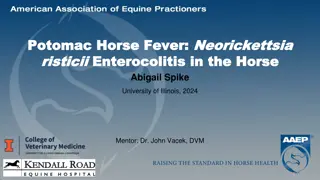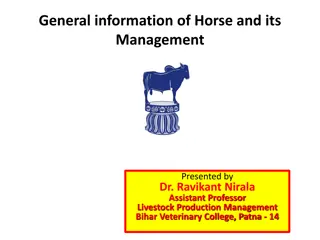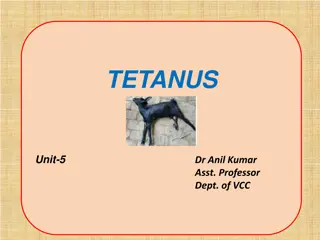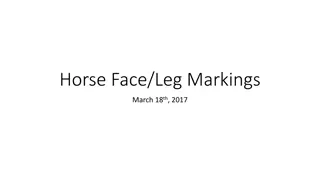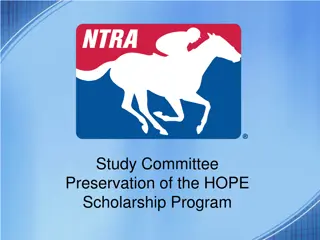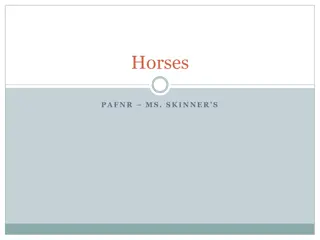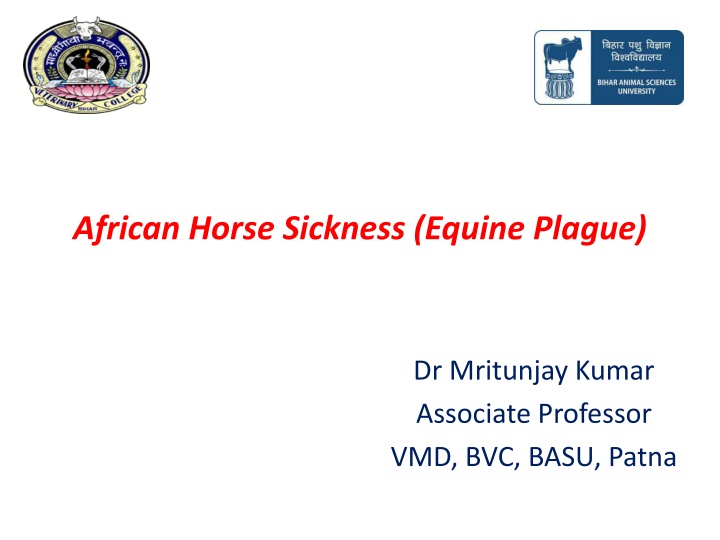
African Horse Sickness - Overview, Symptoms, and Diagnosis
Learn about African Horse Sickness (Equine Plague) caused by the African horse sickness virus. Discover its highly fatal nature, clinical symptoms, pathogenesis, and necropsy findings. Understand the epidemiology, transmission, and diagnostic approaches for this infectious disease affecting horses, mules, and donkeys.
Download Presentation

Please find below an Image/Link to download the presentation.
The content on the website is provided AS IS for your information and personal use only. It may not be sold, licensed, or shared on other websites without obtaining consent from the author. If you encounter any issues during the download, it is possible that the publisher has removed the file from their server.
You are allowed to download the files provided on this website for personal or commercial use, subject to the condition that they are used lawfully. All files are the property of their respective owners.
The content on the website is provided AS IS for your information and personal use only. It may not be sold, licensed, or shared on other websites without obtaining consent from the author.
E N D
Presentation Transcript
African Horse Sickness (Equine Plague) Dr Mritunjay Kumar Associate Professor VMD, BVC, BASU, Patna
It is highly fatal haemorrhagic infectious disease of horses, mule and donkeys (Equidae) and characterised by respiratory and circulatory impairment Etiology African horse sickness virus (AHSV) is a RNA virus of genus orbivirus, family rheoviridae The characteristics are similar to blue tongue virus and nine antigenic strains have been identified Epidemiology Incidence Reported from India, Pakistan and Sub Saharan Africa (Endemic) In India in 1960 about 10,000-30,000 equines died in an outbreak of this disease The mortality rate varies but the mortality rate in horse in 90% and mules and donkeys in 50% Severe disease occurs in horses followed by mules, donkeys and Zebras Zebra acts as reservoir Transmission By haematophagous arthopodes like biting insects like biting midges or gnats Culicoides sp. and mosquitoes
Pathogenesis Upon the bite of the insect, the virus enters the blood and causes viraemia (for 30-90 days) and then localizes in the lungs, hearts and other organs Clinical findings IP 1-3 weeks. There are three forms of the disease 1. Acute form (Pneumonic)/Dunkop horse sickness Fever Later on laboured breathing Paroxysms of coughing Profuse yellowish frothy nasal discharge Profuse sweating Depression Weakness Incoordination, recumbency and finally death The course of the disease 4-5 days
2. Subacute horse sickness (Cardiac form)/Dikkop horse sickness High fever OEDEMA of face especially the temporal fossa, eyelids, lip which may spread to the chest Followed by petechial haemorrhages in the tongue, the oral mucosa will be blue in later stage Paralysis of the oesophagus, inability to ingest feed and water and if ingested will be regurgitated back Increase in the heart and respiratory rates The course of the disease is 2 weeks 3. Mild form/Horse sickness fever Fever (1050F) Poor appetite Slight conjunctivitis moderate dyspnoea
Necropsy findings In pneumonic form there will be hydrothorax, pulmonary oedema, ascites and yellow serous fluid in the upper respiratory tract In the cardiac form marked hydropericardium, haemorrhages in the endocardium and oedema of the head are seen Diagnosis Provisional diagnosis based on clinicopathologic findings Definitive diagnosis is made by agent identification to rule out differential diagnoses EDTA-anticoagulated whole blood or fresh organs (spleen and lung especially) on ice are samples of choice Confirmation best by OIE-validated real-time PCR assay Treatment Administer a course of antibiotic to overcome secondary bacterial infection Make the horse to inhale the vapour of vicks vaporub or amruthaanjan in a bucketful of warm water
Prevention and Control Control the vector by using ecto-parasiticides like malathione, flumetrin etc Keep the horse in fly proof sheds Vaccinate the horse either with the polyvalent live attenuated vaccines or killed vaccines In India during the 1960 outbreak polyvalent live attenuated vaccine containing seven strains has been used with success
Q.1. Which of the is a exotic disease a) Tuberculosis b) Filariosis c) AHS d) None of these Q.2.Which of the following is vector-borne disease a) AHS b) Blue tongue c) Dirofilariosis d) All of these Q.3.AHS causes more severe infection in a) Horse b) Mule c) Donkey d) All of these Q.4.Which of the following disease comes under genus orbivirus a) Blue tongue b) AHS c) Both d) None of these Q.5.Cardiac form of horse sickness is also known as a) Dikkop horse sickness b) Dunkop horse sickness c) Mild form d) All of these
Q.6.Pneumonic form of horse sickness is also known as a) Dikkop horse sickness b) Dunkop horse sickness c) Mild form d) All of these Q.7. Profuse yellow froathy nasal discharge is present in a) Dikkop horse sickness b) Dunkop horse sickness c) Mild form d) All of these Q.7. Oedema of face specially temporal fossa, eye lids and lip present in a) Dikkop horse sickness b) Dunkop horse sickness c) Mild form d) All of these Q.8. OIE validated confirmatory test for AHS a) ELISA b) Real time PCR c) VNT d) All of these Q.9. Which of the following species act as reservoir of AHS a) Zebra b) Horse c) Donkey d) All of these
Equine Infectious Anaemia (EIA, Swamp fever) It is a infectious disease of horse caused by a EIA virus (EIAV) and characterised anaemia, loss of weight, thrombocytopenia and progressive emaciation by intermittent fever, Etiology It belongs to genus- lentivirus, subfamily- lentriniviridae and family retroviridae It is an RNA virus measuring about 80-120 nm with helical symmetry The hypochlorite, chlorhexidine and sodium hydroxide virus is inactivated by formalin, sodium
Epidemiology Incidence Worldwide, horse of all age group are susceptible Morbidity rate is 100% and the case mortality rate is 50% and above Once the horse is infested it must be considered infected for life Transmission Biting flies like tabanus (horse fly) and also by mosquitoes Contaminated syringes and needles and surgical equipments Intra-uterine transmission also can occur Semen of infected stallion and Blood transfusion
Pathogenesis The virus enters the blood by bite of the flies and cause viraemia and then localizes in various organs like spleen, liver, kidney and lymph nodes and also in the epithelium of the arteries The disease is characterised by anaemia which may be due to The virus will bind to the surface of RBC through the nuraminidase and the antibody will bind to the antigen and forms a antigen- antibody complex This complex along with the RBC will be phagocytosed by the macrophages Also such complexes with complement can result in haemolytic anaemia which can be intravascular and extravascular Anaemia due to haemolysis is exaggerated by depression of bone marrow activity and erythropoiesis The life span of RBCs will be reduced from 120-150 day to 28-87 days
Clinical findings IP is 2-4 weeks Usually disease occurs in acute form within a day or between hours Intermittent fever (102-1060F) and this fluctuation can be ventral aspect of the abdomen, prepuce and legs Anorexia, depression weakness, jaundice and edema of conjunctiva Increase in heart and respiratory rates Petechial haemorrhages on oral mucosa and tongue and The course of disease is 10-14 days anaemia, fever, anorexia etc., leading the marked loss of body weight, weakness, pale mucous membrane, emaciation and finally death In the chronic form, the above process is repeated i.e. usually cease after a year Relapses continue to occur at intervals about 2 weeks but
Necropsy findings Petechia accumulation of fluid in cavities, pale mucous membrane and pale muscles or echymotic haemorrhages on serosa, splenomegaly, Diagnosis By signs: Fluctuating fever, anaemia and progressive emaciation in a horse which is not responding to treatment then suspect for EIA Siderocyte counts: Siderocyte is leukocyte containing non-haemoglobin iron/haemosiderin and upon staining such leukocytes is significant and is attributed to EIA Serological Tests: AGID and Enzyme linked ELISA commonly used for detection AGID is commonly known as Coggins test is very reliable test for the diagnosis of EIA by detecting antibodies against EIA virus
Differential Diagnosis Equine babesiosis Ehrlichiosis Equine strongyles Leptospirosis Purpuria haemorrhagica Equine strangles Equine viral rhinopneumonitis Equine viral arteritis Treatment No treatment available, if coggins positive better to euthanize the horse Blood transfusion and haematinics can be used Prevention and Control Thoroughly sterilised the surgical equipments Control of vectors by using ectoparasiticides Live attenuated vaccine (virus passaged in horse leukocytes tissue culture) Best method is to identify the infected animals and euthanize them
Multiple choice questions Q.1. EIAV belonged to a) Flaviviridae b) Retroviridae c) Paramyxoviridae Q.2.EIA is characterized by a) Intermittent fever b) Thrombocytopenia c) Both Q.3. Which of the following causes EIA a) Mosquito b) Tabanus fly c) Contaminated syringe d) All of these Q.4.Petechial haemorrhage and intermittent fever is characteristic by a) AHS b) EIA c) Both d) None of these Q.5.Coggin test is used for the detection of a) AHS b) EIA c) EVA d) All of these Q.6. EIA is characterized by the presence of a) Siderocytes b) Heinz bodies c) Poikiocytosis d) All of these






